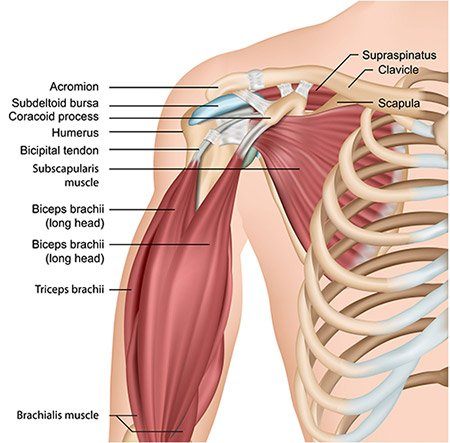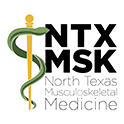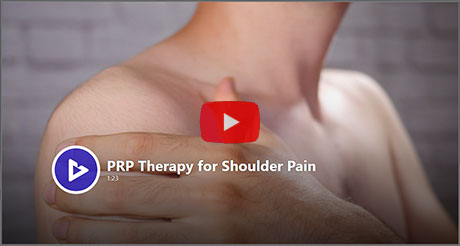Shoulder

The shoulder is the most flexible joint in the body, enabling a wide range of movements. As a result, the shoulder joint is considered the most insecure joint of the body. The support of ligaments, muscles and tendons function to provide the required stability.
Bones in the shoulder are held together by fibrous connective tissue called ligaments, the main source of stability for the shoulder. Ligaments, however, are not particularly flexible. Once stretched, they tend to stay stretched causing laxity in the joint. Small tears often occur, making the tissue susceptible to more serious injury.
Tendons are elastic collagenous, connective tissue that attach muscles to bone and provide stability. The rotator cuff is composed of a group of tendons that connect the deepest layer of muscles to the arm. The crossing of these tendons stabilize the glenohumeral joint. Tearing of this tissue is one of the most commonly occurring tendon disorders, often resulting from traumatic injury or overuse.
Healing of Shoulder Injuries
Although surgical implants, instrumentation, and techniques have improved, healing rates have not improved. Poor tendon healing and irreversible changes associated with rotator cuff injury have been attributed to this lack of success. Understanding of the structure of connective tissue explains the poor healing. Ligaments, cartilage and tendons are composed of collagen, the most abundant protein in the body. The density of collagenous tissue provides strength and stability, but this density also inhibits blood flow. Without adequate supply of healing cells to replenish tissue, collagenous tissue generally does not heal well. Read more about healing of connective tissue.
Treatment Options
Stem Cell Therapy and Platelet Rich Plasma Injections (PRP) accelerate regeneration of healthy tissue to replace damaged cells, helping to strengthen the joint, improve function, and reduce pain. Regenerative procedures are able to compensate for lack of blood flow in connective tissue by inject your own healing cells directly into damaged tissue to enhance repair on a cellular level. Scientific advances in the understanding of how the body actually heals through tissue regeneration provides physicians the knowledge to enhance healing from within, often preventing invasive surgery.
The ability to heal is determined by many factors, some known and some unknown. We do know that when healing is incomplete, tissue damage becomes chronic, leading to arthritis, mechanical dysfunction and harmful stress to adjoining structural areas. Stem Cell Therapy and PRP can help to reduce pain and restore structural function.
Benefits of Regenerative Medicine
Natural Healing:
Regenerative Medicine treatments harness the body's innate healing mechanisms, promoting long-term recovery rather than temporary symptom relief.
Enhanced Tissue Repair:
Regenerative Medicine aims to repair and regenerate damaged tissues, potentially restoring function and reducing the need for more invasive treatments.
Reduced Risk of Side Effects:
Unlike corticosteroids, regenerative therapies generally have fewer and less severe side effects, as they use natural substances from the patient's own body.
What Are Regenerative Medicine Procedures?
Regenerative medicine offers a transformative approach to treating musculoskeletal conditions by harnessing the body's natural healing capabilities to give your body a needed boost to help heal naturally, only faster and better. Bone Marrow Aspirate Concentrate (aka Stem Cell therapy) and Platelet Rich Plasma Injections offer a unique alternative to traditional medical interventions, going beyond symptom management to address the root causes of musculoskeletal conditions. For patients struggling with orthopedic injuries, joint arthritis, or other degenerative conditions that cause pain, stem cell therapy offers a non-surgical option that uses the body’s natural healing power to improve function and reduce pain.
Platelet-Rich Plasma Therapy (PRP): PRP therapy involves extracting a small amount of the patient's blood, processing it to concentrate the platelets, and injecting this platelet-rich plasma into the injured area. PRP is rich in growth factors that promote tissue repair and regeneration.
Stem Cell Therapy: Stem cell therapy uses the patient's own stem cells, typically harvested from bone marrow or adipose tissue, to promote healing. These stem cells can differentiate into various types of cells needed for repair, such as cartilage or tendon cells.
Prolotherapy: Prolotherapy involves injecting a solution, often containing dextrose, into the damaged area. This solution irritates the tissue, triggering the body's natural healing response and promoting the repair of ligaments and tendons.
To determine if Regenerative Orthopedics will be helpful for you, please tell us about your condition.
Common Applications:
- Rotator cuff tears and tendonitis
- Shoulder arthritis
- Labral tears
- Bursitis
- Frozen shoulder (adhesive capsulitis)
- Sports-related or overuse injuries
Understanding the Risks of High-Dose Corticosteroid Injections
Management of pain and inflammation is a critical aspect of care for musculoskeletal conditions. High-dose corticosteroid injections have been standard treatment for conditions such as arthritis, tendonitis, and bursitis. However, while these injections can provide rapid relief, they are not without significant risks.
Corticosteroid injections work by reducing inflammation, thereby alleviating pain. However, the use of high-dose corticosteroids comes with several potential adverse effects:
- Joint and Tissue Damage: Repeated corticosteroid injections can lead to the weakening of tendons, cartilage, and bone. This can result in joint instability and an increased risk of tendon ruptures.
- Osteoporosis: High doses of corticosteroids can accelerate bone loss, increasing the risk of fractures and osteoporosis.
- Infection Risk: Corticosteroid Injections can suppress the immune system, potentially leading to infections such as septic arthritis.
- Endocrine Disruption: Corticosteroids can interfere with the normal function of the adrenal glands, potentially causing hormonal imbalances and conditions such as Cushing's syndrome.
- Short-Term Relief: While corticosteroids can provide rapid pain relief, this effect is often temporary, necessitating repeated injections and increasing the risk of cumulative damage.
We Can Help
To learn more about what we can do to help with your condition, call our office at 817-416-0970. We will thoroughly diagnose your condition and present you with treatment options. From there we will guide you along your road to recovery.

